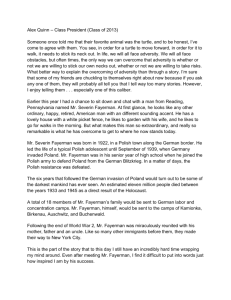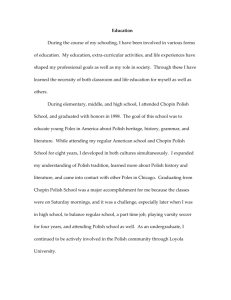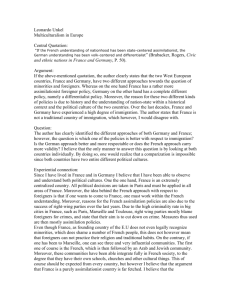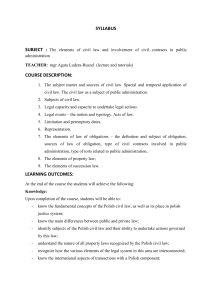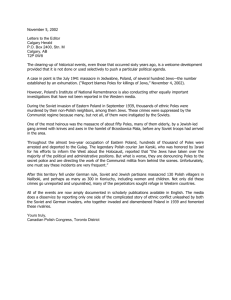“Transnational Xenophobia in Europe? Literary Representations of
advertisement
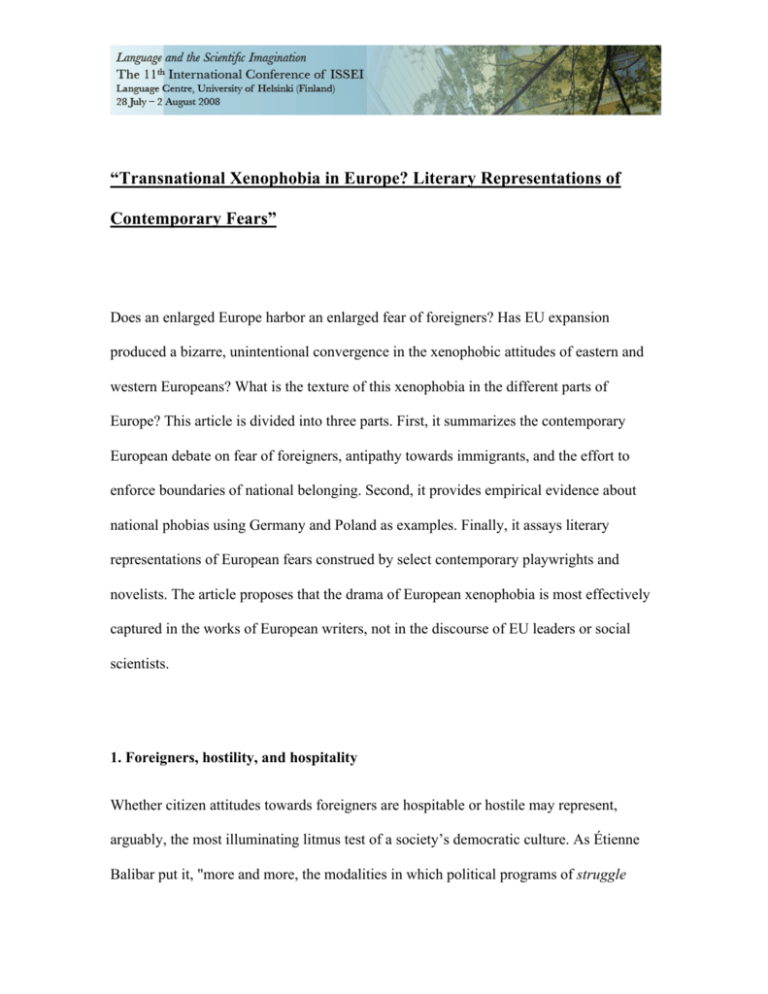
“Transnational Xenophobia in Europe? Literary Representations of Contemporary Fears” Does an enlarged Europe harbor an enlarged fear of foreigners? Has EU expansion produced a bizarre, unintentional convergence in the xenophobic attitudes of eastern and western Europeans? What is the texture of this xenophobia in the different parts of Europe? This article is divided into three parts. First, it summarizes the contemporary European debate on fear of foreigners, antipathy towards immigrants, and the effort to enforce boundaries of national belonging. Second, it provides empirical evidence about national phobias using Germany and Poland as examples. Finally, it assays literary representations of European fears construed by select contemporary playwrights and novelists. The article proposes that the drama of European xenophobia is most effectively captured in the works of European writers, not in the discourse of EU leaders or social scientists. 1. Foreigners, hostility, and hospitality Whether citizen attitudes towards foreigners are hospitable or hostile may represent, arguably, the most illuminating litmus test of a society’s democratic culture. As Étienne Balibar put it, "more and more, the modalities in which political programs of struggle against exclusions and discriminations are defined and put to work constitute the touchstone of democracy in a world in which self-sufficient nationality has disappeared."1 Xenophobia is, literally, a fear of foreigners. Xenophobes are considered to be those people who harbor negative attitudes to foreigners, motivated in large part by a fear of them. An extensive literature studying the psychological basis of xenophobia has pointed to how external threats increase group solidarity and ethnocentrism while, as a corollary, promoting intolerance and closemindedness.2 A pioneering study of the EU explained the dynamics of xenophobia: "Foreigners are seen as carriers of a different culture with the potential to threaten the integrity of one's own nation. The assumption that the nation embodies culture comes from a belief that the nation is the arena in which critical values and beliefs are transmitted to developing members. Since each culture consists of a unique mix of orientations, foreigners inevitably threaten to alter the domestic culture through the introduction of new orientations."3 This understanding of what a national culture consists of transcends individual nations. Western and eastern European nations share a similar approach to protecting their distinct national cultures. The result is that a shared view of foreigners as threatening these cultures may create transnational xenophobia. 2 Hatred of the “foreign” had shaped the politics of nearly all European countries in the 1930s. Anti-Semitism was its most horrific representation. World War II was an unprecedented enactment of racist hatred and led to the slaughter of millions of European citizens who no longer were viewed as belonging to European nations. Joseph Goebbels referred to German Jews as part of world Jewry, international Jewry, and therefore not German. The social construction of who were outsiders, then, had greater political salience than whether the place of origin of an ethnic or religious group was foreign or not. The presence of Jews was viewed as an erosion of the ethnic German community. As Göran Therborn put it, “Like all collective identities, European identity formation has faced two kinds of Others: one outside, beyond the range of the (potential) collective, the second inside, dividing the self to be made.”4 Beginning in the 1950s Europe underwent a transformative process that made a fear of foreigners—those from the outside--salient. European modernity had primarily been shaped by emigration. During the first half of the twentieth century, outmigration, primarily to North America, had helped keep European states homogeneous and had eased their social conflicts. There were some differences among these states, of course. Whereas France was one of the few European countries that did not have sizeable out-migration, Italy had sent wave after wave of its sons and daughters abroad.5 Hard as it is to believe today, postwar migration into Europe--though not new--caught the European public by surprise. Therborn highlighted the unprecedented nature of this development: "The shift from emigration to immigration represents an epochal change in 3 European social history. Ethnic--and largely continental ethnic--conflict has substituted for intra-European nationalist rivalry. The socio-political effect has been to weaken class cleavages and politics in favor of ethnic and other non-class ones."6 While they never completely disappeared in the period of postwar reconstruction, racist and xenophobic politics began to make waves--again—in the 1960s when Europe sought to consolidate its economic comeback. The most important factor stimulating xenophobic attitudes was the foreigner originating from the Third World--not “foreigner” who was a citizen of another European state. To be sure, non-Europeans had been settling on the continent for centuries. But the difference now was in the sheer numbers arriving in a short time span. Though they appeared to be able to accommodate and absorb the new arrivals in practical ways--providing jobs, housing, schools, health care--host societies appeared psychologically unprepared to adapt to large-scale in-migration. Eastern Europe was largely sheltered from the new wave of Third World immigration by the communist cocoon in which it had been placed. It was the advanced western European states that faced the challenge of integrating immigrants and, conversely, developed xenophobic attitudes when integration did not occur on their terms. Historian Walter Laqueur contended that there was something quantitatively and qualitatively different about migrants in the last half century compared to their earlier counterparts: 4 There is, to begin with, the scale of immigration. Only tens of thousands came to Western Europe 100 years ago, not millions. They made great efforts to integrate socially and culturally. Above all, they wanted to give their children a good secular education at almost any price. The rate of intermarriage was high within one generation, and even higher within two. No one helped them: There were no social workers or advisors, no one gave them housing at low or no rent, and programs such as Sure Start (a British equivalent of Head Start) and 'positive discrimination' had not yet been invented. There were no free healthservice or unemployment benefits. There were no government committees analyzing Judeophobia and how to combat it.7 Laqueur’s implication was that the new wave of migration, beginning with Turkish Gastarbeiters to Germany in the 1960s, did not have to struggle to obtain rights; they had these conferred on themselves, in large measure as the product of a German and, more generally, European sense of guilt at their earlier treatment of minority groups, the colonized, and the powerless. “So long as Europe needed both guest workers and increasing populations, there was a convincing psychological explanation for the relaxed immigration regimes of the second half of the twentieth century. A sense of guilt over Europe’s colonial past and then World War II, when intolerance exploded into mass murder, allowed a large migration to occur without any uncomfortable debates over the real differences between migrant and host."8 5 It is also possible to infer from Laqueur’s account that recent immigrants have faced a host society backlash of a relatively benign kind compared to earlier groups of foreigners. The different purposes served by the symbols designating the outsider are instructive. As part of the process of othering in 1940, Jews in Germany were forced to wear a yellow star with Jude inscribed on it. This led directly to persecution and violence directed against Jews. By contrast, in the 1980s and after, othering was often performed by the outsiders themselves. Some Muslim women insisted on marking themselves off by wearing the veil, the headscarf, and even the burqa in public. There was no violent backlash in Western European states against these markers of self-exclusion. The Council of State in France was one of the only political institutions which drew the line at the burqa, announcing in a ruling in 2008 that French citizenship could not be conferred on a woman wearing this Salafist symbol of female subjection because it was in conflict with the values of the French Republic. Fear and dislike of foreigners may partly be the result of a perception that they are a privileged group with special rights, few obligations, and a desire to keep apart from the rest of society. Why citizens come to fear and even hate foreigners is a complex issue, however, and has been the subject of considerable research.9 Often the fear of foreigners is less self-induced than incited by those in authority so as to serve their interests. Simply defining a group as foreign can be an insidious act inciting xenophobic attitudes towards it. Russian literary critic Mikhail Bakhtin identified the importance of "official fear"--an 6 offshoot of the cosmic fear felt by humanity powerless in the face of nature.10 Political elites everywhere know the power of spreading fear among their citizens. Xenophobia is the repudiation of the notion of hospitality. Jacques Derrida theorized about the politics of hospitality offered to strangers. It was contingent in nature because it invariably involved legal and judicial systems grounded in the host society, above all, reflected in its immigration laws. These systems suspended and conditioned the immediate, infinite, and unconditional welcoming of the other.11 As elaborated by sociologist Meyda Yegenoglu, "conditional hospitality is offered at the owner's place, home, nation, state, or city--that is, at a place where one is defined as the master and where unconditional hospitality or unconditional trespassing of the door is not possible." Being ascribed the status of stranger frequently invites hostile reactions. As Georg Simmel contended, "a stranger is not one who comes today and goes tomorrow, but rather as the person who comes today and stays tomorrow."12 It follows that, as Zygmunt Bauman believed, strangers are "always uninvited guests" violating the basis of the host-guest relationship.13 Yegenoglu added: 7 it is not simply the crossing of territorial borders that turns migrants into strangers. Rather it was due to transgressing the dividing line between remoteness and nearness, between temporariness and settlement, inside and outside, that migrants became strangers in Germany. Because they trespass over the allowed borders of guest status, migrants engender uncertainty and ambivalence. By refusing to accept the termination of their allowed period of stay and thereby turning their temporary status into an unexpected permanency, they remain 'stubbornly and infuriatingly indeterminate,' to use a phase from Bauman.14 2. Different Fears in Different Europes? An unstated assumption of EU enlargement has been that western Europe is morally obliged to save its eastern part from itself—its hatreds, paranoias, and squabbles. Yet a 2003 study comparing eastern and western European xenophobia concluded that if there was a higher rate in the east it was "related more to recent structural changes than to more profound understandings of how 'us/we' is conceptualized."15 Two years later another study reported that "If one compares the state of racist extremism in Central and Eastern Europe to that in Western Europe, the differences seem less striking than is often assumed."16 The distinction between a supposed western "civic" xenophobia and an eastern "ethnic" one seems bogus. 8 To be sure, EU enlargement brought political and cultural differences between the two parts of Europe to the surface. Balibar went so far as to claim that "A veritable fracture has thus arisen, a sort of cold war after the Cold War…but one which is both plural and mobile, and which is hidden under a thick mythology about 'clashes of civilizations' between Eastern and Western Europe, supposedly inherited from religious tradition or from the form of state building, when not simply from the ethnic character of the nations involved."17 Balibar sketched a system of concentric circles leading from the "true" Europe (the advanced western states) to an "outer" one asking to be Europeanized (the eastern part).18 The concept of an outer Europe seemed particularly applicable to Poland under the leadership of the Kaczyński twins. Respected Polish intellectual Adam Michnik—a hardened critic of the communist regime--attacked the anti-communist witch hunt that they had launched: Poland's "governing coalition employs a peculiar mix of the conservative rhetoric of George W. Bush and the political practice of Vladimir Putin."19 If anything qualifies as a characteristic of an outer Europe, this combination does. Abroad, the Kaczyńskis alienated both German and Russian leaders with their xenophobic politics and boorish behavior. The words of Immanuel Kant, advocate of a perpetual peace, written in 1798 came to mind: "Poland: that is a very strange country.... With them, there are no middle classes and, thus, they have little culture."20 If Poland for a time seemed to belong to an outer Europe, was this reflected in xenophobic citizen attitudes towards foreigners? How did they compare with the German public’s 9 attitudes towards outsiders? While there are few strictly comparable attitudinal data, it is nevertheless possible to assay the strength and nature of their respective national phobias. A German public opinion survey (ALLBUS) discovered that from 1990 to 2000 more and more respondents concurred that asylum seekers—most of whom come from poor countries in the developing world—should have entry into Germany restricted. The percentage of respondents living in western Germany which asserted this climbed from 50% to 73% over the ten year period. Surprisingly, the 73% figure for 2000 was higher than among the supposedly more xenophobic east Germans (69%). Between 1980 and 2002 Germans increasingly felt that foreigners in their midst should adapt their way of life more closely to the German one. Thirty percent of those in the FRG thought this in 1980 compared to nearly 40% in both parts in 2002. The groups identified in 2006 as having the least similar lifestyles to Germans were, by a wide margin, asylum seekers and Turks. It followed that marriage with a member of these groups was generally frowned upon (Table 1). Respondents were just as adamant that asylum seekers—in practice a proxy for poor people from developing countries--should not enjoy the same rights as Germans, though they were divided over whether Turks should have these rights. Table 1 How pleasant or unpleasant would it be for you if a member of one of the following groups married into your family? 10 Very/quite pleasant Very/quite unpleasant Italians 32 7 German speakers 17 20 Asylum seekers 9 43 Turks 12 40 Jews 19 16 from East Europe Source: Allbus, 2006, Tables V160-164, 128-131. Very/quite unpleasant included the first two (1,2) on the seven-point scale. Quite/very pleasant scores included the last two (6, 7) on the seven-point scale. Survey results from 2006 indicated that the average German was far more hostile to groups coming from far away or which were Muslim than to culturally-affiliated groups like Italians, east European German speakers, and Jews. One noteworthy finding was that 48% of respondents expressed indifference to having Jews as neighbors, reflecting acceptance of the politically correct line. This indifference stood in contrast to evaluations of other possible neighbors where opinion was more polarized. For example, the prospect of an Italian neighbor was appealing: 22% were very favorably disposed and just one 11 percent very negative. At the other end of the continuum, by a ratio of roughly three-toone respondents did not want an asylum seeker as neighbor. The data we have for Polish citizens' attitudes towards foreign groups are not comparable but they still reveal xenophobic orientations in the country. A 2007 attitudinal survey sought to measure Poles' "social distance" from other nationalities and religious groups. Poles were asked the classic question: Would you be opposed to your son or daughter marrying someone who was Jewish, or Russian, or Chinese? One-third of Polish respondents said that they would oppose their child's marriage to someone who was Jewish or Chinese, and one-quarter said they would oppose their child's intermarriage with a Russian. Poles voiced much stronger opposition, however, to interdenominational marriages. Respondents were somewhat more Islamophobic than anti-Semitic with 55% expressing opposition to a son or daughter's marriage with a Muslim and 47% with a Jew. Poles relented somewhat if a possible son-in-law or daughter-in-law was Christian: Orthodoxophobic views were expressed by the 38% of respondents who would oppose a son or daughter marrying someone of this faith. Marrying a Protestant was less critically perceived (31%). Antipathy towards a possible atheist son- or daughter-in-law was at about the same level as for an Orthodox one (37%). Someone of the same nationality and religion were two of the most important characteristics respondents looked for in a spouse, or friend, for that matter. Only the 12 factor "way of comporting oneself in public"--let's call it "having good manners"--was seen as more important than religion or nationality in a potential spouse. Educational level, occupation, and political views were less influential.21 A longtitudinal analysis of survey results indicates important trends in the changing national likes and dislikes of Poles. In 1993 Italians, Americans, and Italians were bunched at the top of Poles' favorite nationalities. By 2006, however, six EU cohorts-Spaniards, Italians, Czechs, English (which Poles use interchangeably with British), Dutch, and Irish--ranked higher than Americans The sudden popularity of Spaniards and Irish is explained by the fact that these are two Catholic EU countries with which Poland has sometimes made common cause on EU policy. They have also been welcoming to Polish workers looking for jobs in the west. Poles' least preferred nationalities changed only slightly over this same period. In 1993 Romanians were the least favorite: a -57% net difference between those saying they liked and those saying they disliked them! When Roma were added to the survey the next year they immediately overtook Romanians ( 69% in 1994). Three mainly Orthodox nations-Ukrainians (-53%), Serbs (-45%) and Russians (-39%)--came next. Belorussians did not fare well either (-28%). But they were still comfortably ahead of Germans (-53%) and Jews (-36%). By a large margin (a -57% differential), Poles' least favorite "nation" in 2006 were the Arabs, who were first included in the survey in 2002. Roma came next (-44%) followed 13 by their namesake, Romanians (-36%). Turks followed (-31%) with Jews, Russians, and Serbs Orthodox tied at -25%. As many Poles now said they liked their EU western neighbors as said they did not care for Germans (at 33%).22 Poles’ strong dislike of Arabs and Turks suggests that Poles suffer from a degree of Islamophobia, just like Germans do. To some extent Poles may be seen as Orthodoxophobes too, though it can be argued that dislike of Russians, in particular, has little to do with religious differences and everything to do with history. Finally, even though dislike of Romanians, Roma, and Jews--the latter two groups, significantly, often perceived as homeless, nomadic nations--has been declining, Poles share the historic antipathy towards such perceived "bogeyman nations" with many of their fellow citizens in Europe. Germans are more guarded in giving their views on Jews but they are more candid in expressing antipathy towards asylum seekers and, to a lesser extent, Turks— groups that are considered non-Europeans. 3. Cultural Narratives of Foreigners, Fears, and Self Loathing A particularly illuminating literary genre that captures relations between “locals” and “outsiders,” and between fixed identities and those in flux as a result of migration, is theatre. The sense of belonging and the process of othering--emotional and psychological phenomena that can be made tangible on stage—are themes that especially lend themselves to theatrical representation. It is no surprise, therefore, that many European playwrights and directors have addressed these subjects. 14 An eastern European classic is Polish writer Sławomir Mrożek's The Immigrants. Directed by Andrzej Wajda, the legendary film director, it premiered in a Warsaw theatre in 1976, at a time when many Poles were, for the first time under communism, able to leave the country to work--usually illegally--in Western countries, then return with savings that made them rich back home. The play features two characters: an intellectual and a worker from an unnamed far-away nation living together in a decrepit rented flat in a foreign country. The dialogue captures the hopes and fears of two men from very different social classes, brought together by their sense of belonging to a common ancestral home, by their living in a society alien to both of them, and by their common realization that their personal identities were in flux. The theme of emigration was resurrected by Polish theatre director Krzysztof Warlikowski. His production of Israeli writer Hanokh Levin's Kroum, staged during the 2005 summer theatre season in Avignon, was widely acclaimed.23 The story concerns a man returning to his home country after a long trip abroad. Dressed in a cowboy hat and pulling a suitcase on wheels behind him, he arrives in his house in a dank quarter of TelAviv--a district that could be anywhere in Europe, or elsewhere. Kroum is reunited with his mother but he has an admission to make. "Mama, I haven't succeeded. I haven't found fortune or happiness abroad. I haven't progressed an inch, I didn't haven't fun, didn't marry, didn't even get engaged. I didn't meet a soul. I didn't buy 15 anything and didn't bring anything back. There's only dirty laundry and toiletries in my suitcase." Born in Tel-Aviv, the playwright Levin is a descendent of a well-known line of Hassidic rabbis from Poland. His satirical writings have often had Israel as a target, including how it changed after its victorious 1967 six-day war. Kroum confronts the loss of meaning and identity in a globalized world where individuals roam about striving for social advancement. Home is where they are fixed in the social hierarchy with few prospects of upward mobility. Thematically similar to Kroum is Ariane Mnouchkine’s "pageant of the uprooted"--Le Dernier Caravansérail (Odyssées).24 The title is meant to be ironic: a caravansérail is rooted in the Persian word which means palace, or the spacious place where caravans put up for a rest. Mnouchkine’s odyssey is a testimonial to the new existential nomads who wander the world, looking for landfall which they can call home. The six-hour saga is set in detention camps in France, Australia, New Zealand, and Indonesia. For Mnouchkine, a French avant-garde stage director who improvised the piece from narratives collected from refugees between 1999 and 2002, a cast of 36 represents the twelve million people trapped in the ghost life of detention centers and legal limbo around the world. "I hope the audience will follow our wanderings as we followed yours," 16 Mnouchkine implores in the Übertitel that opens Part 2. Wandering and unknowing are the experiences of the asylum seekers, and they are the tropes of this sprawling production. Through the caprice of history, émigrés find themselves with no rights, no voice, no place. The first scene in Le Dernier Caravansérail is of refugees trying to cross a raging river between Kyrgyzstan and Kazakhstan. They are hoisted over the torrent in a wicker basket whose rope and pulley are operated by a smuggler. The wind roars and the refugees’ shouts are muffled. The actors rappel horizontally across the stage. They slip, they struggle. A woman hesitates, then plunges into the current before she is hauled back up into the bobbing basket. One man is not so lucky: he is swept away. While upstage the audience sees him disappear in a swell, downstage we witness a drama being acted out about payment to a human smuggler. The image of water symbolizes the danger, bravery, desperation, and grueling physical and emotional costs of exodus. When, finally, the asylum seekers are safely on the other side, they trade insults with the smuggler: "Kyrgyz bastards! You race of dogs!" And the reply: "Kazakh bastard...! Stop moving across my country." Theatre in both new and old Europe captures the aspirations and desperation of populations moving across the world's borders. Hostility is more often what their migration evokes--not hospitality. But another subject that has appealed to European 17 playwrights is national self loathing—the discomfort of having to belong to a national group. Czech-born British playwright Tom Stoppard set his recent trilogy, The Coast of Utopia, in Russia of the 1830s. Featuring an imaginary debate among the great characters of the time, the play anticipates the questions that still haunt European identity today. Peter Chaadaev, the philosopher, asks about Russia: "How did we come to be the Caliban of Europe?"25 Vissarion Belinsky, the literary critic, summarizes a manuscript he has been reading: "it's all about how backward Russia is compared with Europe...the rest of Europe, sorry."26 The great anarchist Michael Bakunin expresses his frustration about rebellion in tsarist-governed Congress Poland: "Poland is simply impossible."27 Stoppard gives us a clear and concise summing up of the longstanding antipathies in the east of Europe. One of the great fears that divides Europe today is Russophobia. While western European nations have generally sought to accommodate Russia and institutionalize its place in European structures, eastern European countries continue to invoke Russia’s history of expansionism in order to exclude it from the European project. A pastiche of Polish Russophobia is at the core of the fictional world of Dorota Masłowska, a young writer who has documented the underclass trying to survive in the Poland of capitalism without a human face. It is not a world marked by upward mobility, prosperity, overnight fortunes, country villas, conspicuous consumerism. It consists instead of disempowered youth, junkies and alcoholics, wannabe rock musicians, racist skinheads, their vulgar language and uncouth habits, the bonds they forge with each other, and the dead ends they face in life. 18 Masłowska's first novel (and her only book available in English) is called Snow White and Russian Red; the more descriptive Polish title is "The Polish-Russian War under the Redand-White Flag." It presents a hyper-realistic portrait of small-town Polish society of the 1990s. Nails, a socially marginalized kid dumped by his girlfriend Magda, turns to drugs, gutter punks, and xenophobia as surrogates. The novel spotlights both the anarchic and russophobic attitudes of young people in Poland--paradoxically the generation that had suffered least at the hands of Russian-imposed rule. Russkis--a pejorative word for Russians when used by Poles--are blamed for controlling the black market in knock-off cigarettes, pirated CDs, even Polish sand--these are some of their economic wrongdoings. They have raised the salinity of the Niemen river and are responsible for the arrival of gale-force winds--their part in environmental degradation. They also go off with grubby-faced dirty girls, demonstrating their lack of taste and culture. There are few insults that can be hurled in Poland worse than to say your "mother takes off her panties for the Russkies."28 By contrast, the best testimonial a Pole can receive is: "radically anti-Russki with right-wing tendencies," which denotes "individual achievements in the advancement of Polishness.'"29 The thinking pervading much of Polish society is, then, "Either you're Polish or you're Russki. To put it more bluntly, either you're a person or you're a prick."30 19 In 2006 Masłowska's first play, "Two poor Romanians speaking Polish," was staged in Warsaw. The main characters are a middle-aged Romanian couple hitch-hiking through Poland who encounter anti-Balkan antipathies. One Polish driver comments how he heard that "in that Romania they eat thorns, weeds, and rocks."31 A Polish woman who gives them a lift wants to show how much she knows about the Balkans: "Fuck. Hungary, Romania, Turkia, I know, a beautiful country. Everyone says Romania, filth, shit, excrement, Islam, kids eating shit from the sidewalks, that tyrant Cincinnatus ruling."32 Eastern European self-loathing again makes its appearance in the play. Parcha, the Romanian husband, lashes out at his wife Dżina: "You have no shame! Woman, you're pregnant, you sniff glue, you curse, you stink up the car." He tells the first driver that picks the couple up: "You have to excuse her, she's a dumb Romanian, a lout, she worked her whole life in a factory of monkeys and dogs and doesn't know how to behave in public."33 Later he explains to a drunken middle-class Polish woman driving to Warsaw: "we're Romanians who speak Polish, we're lesbians, queers, Jews, we work in an advertising agency, like I said you know, we're going to Israel to plant trees."34 Whether the couple really are Romanians speaking Polish or drunken Poles playing a prank and mimicking Romanians speaking Polish is an academic question. In the first case, the two Romanians reach for what they guess is the negative Polish stereotype of their country. In the second, the two Poles try to capture the self-loathing Romanians feel as Romanians traveling in a more “western” country. 20 If eastern Europeans still smolder about each other in their own paranoiac world, Islamophobic narratives have increasingly marked western Europe’s literary scene. Michel Houellebecq has reveled in the controversy that his "frank" depictions of Islam, for example, in Platform published in 2002, has evoked. Ultimately the author holds Western liberalism and rationalism to blame for tolerating such a stupid religion (he was brought to court for inciting violence against Islam but was acquitted). The Western world has become so flabby that it cannot defend itself any more against reactionary ideologies like Islamo-fascism. "Because of its need for rational certainty, the West finally sacrificed everything: its religion, its happiness, its hopes, and definitively its life."35 Houellebecq highlights the sordidness of today’s ethnic hatreds; few ethnic and racial groups have not been skewered in one of his books--French society included (in Elementary Particles). He adopts the traditional patronizing French view of its neighbor to the south: "standardization was doing its work… and Spain was approaching European, and especially English, norms." It was giving grudging acceptance to such extraordinary ideas as homosexuality, kindness to animals, vegetarian food, and New Age baubles.36 Spain, where much of Possibility of an Island is set (and Houellebecq currently lives), is still not quite old Europe, however: "Spaniards don’t like cultural programs at all, nor culture in general, it’s an area that is fundamentally hostile to them."37 21 The author ridicules job seekers from eastern Europe even if the threat of the Polish plumber has no currency for him. In the brothels visited by David1, the main protagonist of Possibility of an Island, "most of the girls were Romanian, Belorussian, and Ukrainian, in other words from one of those absurd countries that emerged from the implosion of the Eastern bloc."38 The pornography industry "remained in the hands of shady Hungarian, or even Latvian, jobbers."39 Aging tourists at a holiday club are entertained to a Miss Bikini Contest where the main contestants are a leggy teenage girl from Budapest and "a platinum-blond Russian, very curvaceous in spite of her fourteen years, who looked a right tart" and subsequently "began stuffing her hand down her bikini bottom."40 After inevitably losing his slutty girlfriend to younger men, Daniel1 thinks to himself how "I could spend the night with a transsexual Slovenian whore."41 The most offensive satires of foreigners in his novels are of Muslims. One character in Platform snarls: "Islam was born in the middle of the desert in the middle of scorpions, camels, and ferocious animals of all types. You know what I call Muslims? The scum of the Sahara...Islam could not be born except in a stupid desert among filthy Bedouins who had nothing else to do but--pardon me--bugger camels."42 There could be no doubt but that "the Muslim system was condemned: capitalism would be stronger. Already young Arabs dream of nothing else but sexual consumption."43Anti-Arab invective is found in other novels. In Elementary Particles Anne speaks of a holiday in Morocco where "the Arabs were disagreeable and aggressive, the sun was much too hot."44 In Possibility of an Island, Daniel1’s artistic output includes a rap record "Fuck the Bedouins," songs such as 22 "Let’s Fuck da Niggahs’ Anus," and a creation called We Prefer the Palestinian Orgy Sluts.45 Houellebecq has been accused of misoxenia, blasphemy, and sexism--and racism. Invoking the most classic of stereotypes, Bruno in Elementary Particles remembers as an adolescent measuring his penis, which was only 13-14 centimeters long, at most. "It was from that moment on that I started hating Blacks."46 Elsewhere the French author speaks about a past colonial view of blacks as "an inferior brother," which constituted "a kind of benevolent, almost humanist, racism." But "From the moment that whites began to consider Blacks as equals, it became clear that sooner or later they would consider them as superior. The notion of equality has no foundation with man."47 Again blaming the West for encouraging jumbled ethnic hierarchies, "racial discrimination in reverse" also applied to Arabs, seen as inherently superior to Europeans.48 The author's exposé of western Europe's xenophobia—or is it his own?--adds a rich, personal texture to the phenonomenon. What is an emigrant to Europe—indeed, one in the first wave of Gastarbeiters coming from Turkey to Germany—to make of national fears, antipathies, and prejudices appearing on the continent? Emine Sevgi Özdamar arrived in 1965 at the age of nineteen and became fluent in German, allowing her to be a writer as well as an actress in her adopted home. Her first novel published in English was Mother Tongue. Her work "aimed 23 to capture an elaborate, multicolored snapshot of Turkish culture and migration experience" and to express "her longing for forgotten words and sounds of Turkish and Koranic Arabic."49 Her identity is located both in the home country and the receiving society, both in the remnants of a mother tongue (Turkish) and a foreign tongue (German) which has become her native tongue. Not surprisingly, "'For Germans, I'm a Turk, for Arabs German.'"50 The author describes herself as a story teller who narrates in German, "the language of my day-to-day experiences" and "the language of some five million Gastarbeiters."51 In Mother Tongue, the narrator is told to explain what she is doing in her adopted country: "'What are you doing in Germany?'" asked the girl. I said: 'I'm a word collector.'"52 She lists all the Turkish and Arabic words that she has collected. In the afterword Özdamar writes: "We have no choice but to rebuild the tongue which we have lost with the tongue that we have found."53 Although xenophobic attitudes are not palpable in her novels, ethnic stereotypes abound. Mutual constructions of the Other are on the surface respectful but in reality absurd. A donkey and farmer are heading for "Alemania." The donkey says: "'Didn't you hear? It rains pearls in Germany.'"54 A Turkish woman traveling to Germany tells her companions: "'I have seen their women. They iron and iron their hair. They sew up their bosoms every day or flop, let them hang down. Allah gave each of them an arse, but they only jiggle 24 with it, zirr--zirr--zirr.'"55 A Turkish man with his flock of sheep stands at the "Door to Germany" and warns a Turkish woman standing beside him: "'Woman, if you don't want to take the man's smelly cock in your mouth, then you should have cut off your legs and stayed at home.'"56 Apart from Turkish self-loathing and stereotyping, Özdamar draws a pastiche of the proxenetic German who prides himself in his knowledge about Turkish culture. But even the self-congratulating advocate of multiculturalism finds a way to be cutting even when he is trying to be nice. The author elaborates: "along came a German, a lover of Turks" who talked incessantly about his friend who was Turkish. The German and his wife once stayed at the Turk's house. What did his wife and the Turk do? "They fucked and they fucked." Later the German tells some Turks he meets on the street: "In your country, you wash your arse with water after you have a crap, isn't that true? You see, I know that....I also always wash mine here."57 The absurdity of rote multicultural discourse is made evident. Similar tropes are presented in Özdamar's Life is a Caravanserai, published in English in 2000. The novel describes a girl growing up in a rough social milieu in Turkey in the 1950s and 1960s before she decides to emigrate to Germany. There was a hurdle to leap in order to quality for immigration to Germany: "In order to go to Germany you had to have medical tests, give urine samples, give blood samples, show your teeth." The narrator happily reported she had received her visa: "I had good urine. My path was clear."58 25 Prospective immigrants were given a "Handbook for Workers Going to Work Abroad." There was some plain advice for women: "In Europe you don't wear headscarves. If Turkish women wear headscarves, Europe will not love them."59 The images of Germany were favorable. Turkish women believed that "When you get your period in Germany, you don't have to work, you get those days off."60 A Turkish woman remarked that "you'll find only cultured Turks there."61 But the train bound for Germany carried almost all Turkish women and they did not appear cultured. In a tone of self-parody Özdamar writes: "It was a train of whores....the train divided up into whores who combed their hair with men's semen and whores who spread men's semen on their bread and ate it."62 Özdamar can write lyrically about her childhood on the border of Europe. Her parents had moved several times between the Asian and European sides of Istanbul. When traveling to European Istanbul on business, her father would choose elegant trousers and a shirt the night before. "During the night the white of the shirt would shimmer before my eyes, and it seemed as if the trousers and the shirt were so excited about their forthcoming trip to Europe that they were unable to sleep."63 The author also recounts a time sunbathing topless on one of the islands near Istanbul. A motorboat suddenly passed by and one of the men remarked about her: "Today is a fine day for looking at European goods."64 26 4. Transnational Xenophobia? National stereotypes, antipathies, phobias, rivalries, and biases still affect attitudes and behavior in old and new Europe. Western European publics have become more concerned about their burgeoning immigrant communities while eastern European citizens have tended to focus on the ethnic, religious, and regional squabbles of the past. If Muslim groups are most often othered in old Europe, by contrast it is Russians, Romanians, Roma, and Turks who are made into the alterity of eastern Europe. The phenomenon of xenophobia is transnational, therefore, but its targets differ from one region to another. European leaders have called attention to the rise of xenophobia. In 2008 they adopted a European Pact on Immigration and Asylum that highlighted how the EU had to be able to receive immigrants “with dignity.” That same year German Chancellor Angela Merkel used the occasion of the seventieth anniversary of the anti-Semitic riots of Kristallnacht to condemn all forms of racism; her views were echoed by Pope Benedict XVI. Nevertheless it is writers who speak to us most clearly about racism, xenophobia, hostility, and fear. Politicians rarely use words to tell the truth, but writers invariably do.65 It is to Europe’s cultural intelligentsia that we must turn for an understanding of the gravity of contemporary European fears. Ray Taras Tulane University Department of Political Science 27 New Orleans, Louisiana 70118-5698 U.S.A. taras@tulane.edu 1 Etienne Balibar, We, the People of Europe? Reflections on Transnational Citizenship (Princeton, NJ: Princeton University Press, 2004), 24. 2 Gallya Lahav, Immigration and Politics in the New Europe: Reinventing Borders (Cambridge: Cambridge University Press, 2004), 189-190. 3 Sara De Master and Michael K. Le Roy, "Xenophobia and the European Union," Comparative Politics, 32, no. 4 (July 2000), 425. 4 Göran Therborn, European Modernity and Beyond: The Trajectory of European Societies 1945-2000 (London: Sage, 1995), 243. 5 Craig Parsons, Immigration and the Transformation of Europe (Cambridge: Cambridge University Press, 2006). 6 Therborn, European Modernity and Beyond, 51. 7 Walter Laqueur, "So Much for the New European Century," The Chronicle of Higher Education (11 May 2007), B7. See his The Last Days of Europe: Epitaph for an Old Continent (New York: Thomas Dunne Books), 2007. 8 Dan Bilefsky and Ian Fisher, "Across Europe, Worries on Islam Spread to Center," New York Times (11 October 2006). 9 For an overview see my Europe Old and New: Transnationalism, Belonging, Xenophobia (Lanham, MD: Rowman and Littlefield, 2009). 10 Mikhael Bakhtin, discussed by Zygmunt Bauman, Wasted Lives: Modernity and its Outcasts (New York: John Wiley, 2004), 46-53. 11 Jacques Derrida, Adieu to Emmanuel Levinas (Stanford, CA: Stanford University Press, 1999). 12 Georg Simmel, "The Stranger," in The Sociology of Georg Simmel (New York: Free Press, 1964), 402. 28 13 Zygmunt Bauman, Postmodernity and its Discontents (Cambridge: Blackwell, 1997), 6. 14 Meyda Yegenoglu, "From Guest Worker to Hybrid Immigrant: Changing Themes of German-Turkish Literature," in Migrant Cartographies: New Cultural and Literary Spaces in Post-Colonial Europe, eds. Sandra Ponzanesi and Daniela Merolla (Lanham, MD: Lexington Books, 2005), 143-144. Zygmunt Bauman, Modernity and Ambivalence (Ithaca, NY: Cornell University Press, 1991), 65. 15 Mikael Hjerm, "National Sentiments in Eastern and Western Europe," Nationalities Papers, 31, no. 4 (December 2003), 419. 16 Cas Mudde "Central and Eastern Europe," in Racist Extremism in Central and Eastern Europe, ed. Mudde (London: Routledge, 2005), 281. 17 Balibar, We, the People of Europe? 167. 18 Balibar, We, the People of Europe? 169. 19 Michnik, "Waiting for Freedom, Messing it Up," New York Times (27 March 2007). 20 Immanuel Kant, "The Contest of Faculties (1798)," in Kant: Political Writings, ed. Hans Reiss (Cambridge: Cambridge University Press, 1991), 182-83. 21 Centrum Badania Opinii Spolecznej, "Przejawy dystansu spolecznego wobec innych naradodow i religii" (Warsaw: CBOS, January 2007), BS/3/2007. 22 Centrum Badania Opinii Spolecznej, "Stosunek polakow do innych naradow" (Warsaw: CBOS, October 2006), BS/148/2006, <www.cbos.pl> 23 Fabienne Darge, "Kroum," Le Monde (23 July 2005). 24 From a review by John Lahr, "The New Nomads," New Yorker (8 January 2005). The Théâtre du Soleil’s production ran at the Lincoln Center Festival until August 2005. 25 Tom Stoppard, The Coast of Utopia: Part I Voyage (New York: Grove Press, 2002), 82. 26 Stoppard, The Coast of Utopia: Part I, 30. 27 Stoppard, The Coast of Utopia: Part I, 13. 28 Dorota Masłowska, Snow White and Russian Red (New York: Black Cat, 2005), 219. 29 Masłowska, Snow White and Russian Red, 255. 30 Masłowska, Snow White and Russian Red, 120. 29 31 Dorota Masłowska, Dwoje biednych Rumunów mówiących po polsku [Two poor Romanians speaking Polish] (Warsaw: Lampa i Iskra Boża, 2006), 13. 32 Masłowska, Dwoje biednych Rumunów, 63. 33 Masłowska, Dwoje biednych Rumunów, 30. 34 Masłowska, Dwoje biednych Rumunów, 62. 35 Michel Houellebecq, Les particules élémentaires (Paris: Éditions J'ai lu, 2003), 270. The English edition is Elementary Particles (New York: Knopf, 2001). 36 Michel Houellebecq, Possibility of an Island (New York: Knopf, 2006), 51. 37 Houellebecq, Possibility of an Island, 216. 38 Houellebecq, Possibility of an Island, 72. 39 Houellebecq, Possibility of an Island, 110. 40 Houellebecq, Possibility of an Island, 181-182. 41 Houellebecq, Possibility of an Island, 223. 42 Michel Houellebecq, Platforme (Paris: Éditions J’ai lu, 2002), 243-244. The English edition is Platform (New York: Knopf, 2003). 43 Houellebecq, Platforme, 339. 44 Houellebecq, Les particules élémentaires, 186. 45 Houellebecq, Possibility of an Island, 100. 46 Houellebecq, Les particules élémentaires, 191. 47 Houellebecq, Platforme, 112. 48 Houellebecq, Platforme, 195. 49 Quoted in Levent Soysal . "Review of David Horrocks and Eva Kolinsky, eds, Turkish Culture in German Society Today," H-SAE, H-Net Reviews (May, 1998), at http://www.hnet.org/reviews/showrev.cgi?path=23277895266619. 50 Emine Sevgi Özdamar, Mother Tongue (Toronto: Coach House Press, 1994), 113 51 David Horrocks and Eva Kolinsky, eds, Turkish Culture in German Society Today (New York: Berghahn Books, 1996), 47. 30 52 Özdamar, Mother Tongue, 57. 53 Özdamar, Mother Tongue, 157. 54 Özdamar, Mother Tongue, 72. 55 Özdamar, Mother Tongue, 78. 56 Özdamar, Mother Tongue, 81. 57 Özdamar, Mother Tongue, 100. 58 Emine Sevgi Özdamar, Life is a Caravanserai--Has Two Doors--I Came In One--I Went Out the Other (London: Middlesex University Press, 2000), 288, 290. 59 Özdamar, Life is a Caravanserai, 295. 60 Özdamar, Life is a Caravanserai, 289. 61 Özdamar, Life is a Caravanserai, 288. 62 Özdamar, Life is a Caravanserai, 295. 63 Emine Sevgi Özdamar, "Guest Faces," in Ursula Keller and Ilma Rakusa, eds., Writing Europe: What is European about the Literatures of Europe? (Budapest: Central European University Press, 2004) 225. 64 Özdamar, "Guest Faces," 227. 65 I am paraphrasing Salman Rushdie’s comments to me in New Orleans (7 April 2008). 31
